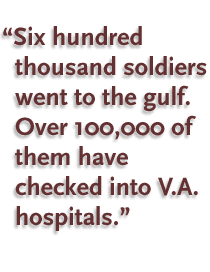 harles Sheehan-Miles, 25, went to the Persian Gulf War a healthy man. Within a year of his hero's return to the States, he was diagnosed with melanoma, a cancer he believes was caused by exposure to uranium dust from a burning tank. The super-hard, nontoxic metal (used in tank armor and artillery-shell casings) oxidizes on impact into a highly toxic dust -- or so the information-packed website for the National Gulf War Resource Center tells us.
harles Sheehan-Miles, 25, went to the Persian Gulf War a healthy man. Within a year of his hero's return to the States, he was diagnosed with melanoma, a cancer he believes was caused by exposure to uranium dust from a burning tank. The super-hard, nontoxic metal (used in tank armor and artillery-shell casings) oxidizes on impact into a highly toxic dust -- or so the information-packed website for the National Gulf War Resource Center tells us. As the prime mover behind the resource center and its website (which he started after linking up with several fellow vets online), Charles is aware that there are skeptics of the mysterious, multifarious Gulf War Syndrome disease. But "people have been very sympathetic and interested in action," he says. "No one is arguing about whether these guys are sick. Six hundred thousand soldiers went to the gulf. Over 100,000 of them have checked into V.A. hospitals, and the numbers are still going up. "The Net offers a way for gulf vets to get information and get connected with one another," Charles says. "There's hope when you realize you're not alone. There are about 30 grassroots gulf vet groups serving about 100,000 vets. Collaborate and disseminate -- that's what we do. Vietnam vets took years and years to start this kind of network and get this kind of information. Technology has helped speed things up for us enormously."
|





